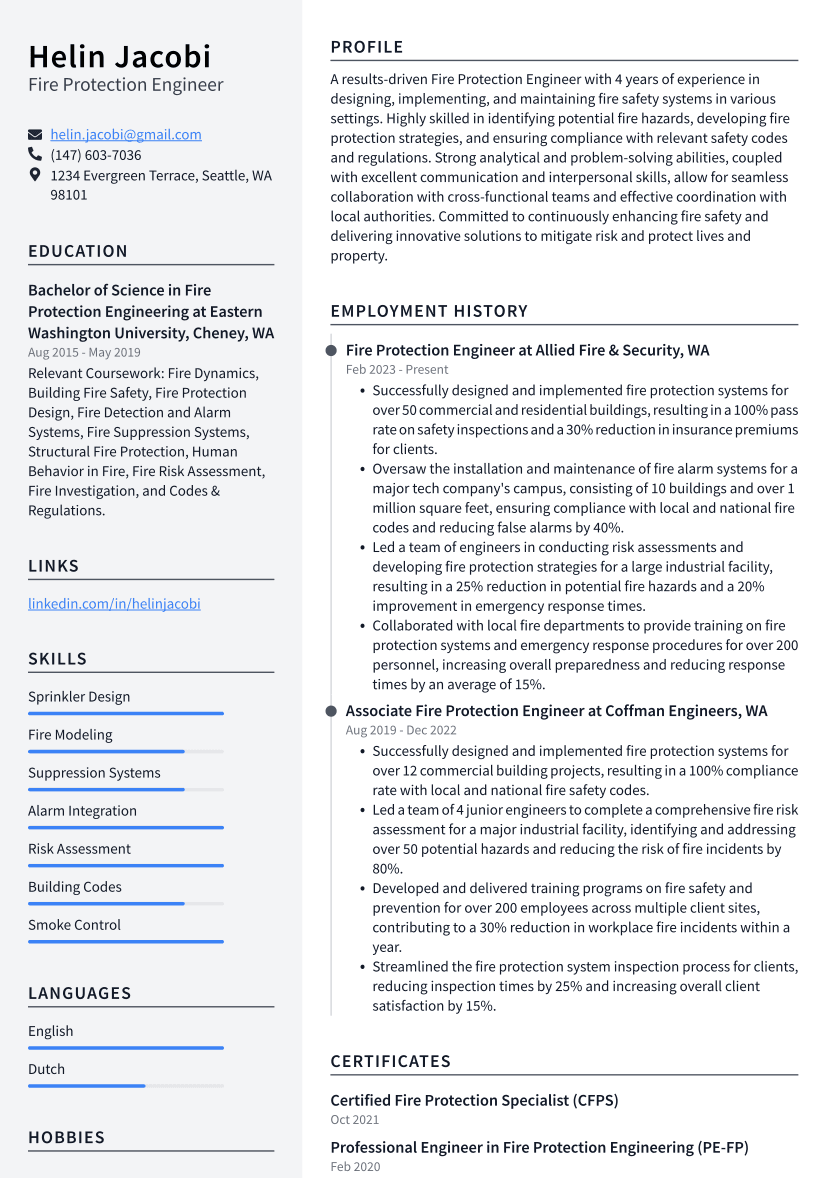Fire Protection Engineer Resume Examples
Writing a great fire protection engineer resume is important because it is one of the first things a potential employer will see when they are considering you for a position. It is your opportunity to make a good first impression and sell yourself as the best candidate for the job.
Create your resume
Select from 7 professional resume templates
If you're looking for inspiration when it comes to drafting your own fire protection engineer resume, look no further than the samples below. These resumes will help you highlight your experience and qualifications in the most effective way possible, giving you the best chance of landing the fire protection engineer job you're after.
Essential Components for a Fire Protection Engineer's Resume
A resume for a Fire Protection Engineer should be a comprehensive reflection of one's expertise, work history, and educational background in the field. Given the critical nature of fire safety, it's imperative that your resume effectively communicates your proficiency in protecting life and property from fire hazards.
Key sections to include are personal information, a targeted objective statement, professional experience, education and certifications, technical and soft skills, professional affiliations, and a portfolio of past projects or references.
Below, we delve into each section, offering insights on what to include and how to present your qualifications in a manner that resonates with potential employers.
1. Contact Information
At the top of your resume, ensure your contact information is prominent and current. Include your full name, phone number, professional email address, and optionally, your LinkedIn profile or professional website. While a full home address is not mandatory, do list your city and state if you're open to relocation.

Accuracy here is critical; any mistakes could mean a missed connection with a potential employer.
2. Objective Statement
Begin with a concise and compelling objective statement. This should succinctly outline your qualifications and career aspirations, tailored to the specific role you're applying for. Highlight your expertise in fire safety regulations, risk assessment, and system design, and express your dedication to safeguarding against fire hazards.
For example: "Dedicated Fire Protection Engineer with over 10 years of experience in system design and risk assessment, seeking to contribute to XYZ Company's commitment to building safety and fire prevention."
Customize this statement for each application to reflect the job description and demonstrate your suitability for the role.
3. Education and Certifications
Your academic credentials and certifications are testament to your technical knowledge and commitment to the field. List your degrees in fire protection engineering or related disciplines, and detail any relevant certifications from recognized bodies like NICET or the NCEES PE license. Highlight ongoing professional development efforts, such as SFPE seminars or additional training.
4. Relevant Work Experience
Chronologically list your work history, emphasizing roles pertinent to fire protection engineering. Use bullet points to describe key responsibilities and achievements, quantifying your impact where possible. Tailor this section to the job description, ensuring that your experience aligns with the skills and expertise the employer is seeking.
5. Skills and Expertise in Fire Protection Engineering
Showcase both your technical proficiencies (e.g., AutoCAD, NFPA codes) and soft skills (e.g., communication, problem-solving). This section should reflect your ability to perform essential job functions and collaborate effectively with a team. Continuously update your skills to keep pace with industry advancements.
6. Professional Affiliations or Memberships
Include memberships in organizations like NFPA or SFPE to demonstrate your engagement with the fire protection community. Detail any active roles you've held within these organizations to further illustrate your leadership and commitment to the field.
7. References or Portfolio of Past Projects
Provide references who can attest to your professional abilities and character. Complement this with a portfolio section that showcases your most significant projects, ensuring you respect confidentiality agreements. This tangible proof of your expertise can be a powerful tool in securing an interview.
By carefully crafting each section of your resume, you can present a compelling narrative of your qualifications as a Fire Protection Engineer, positioning yourself as an invaluable asset to potential employers.
